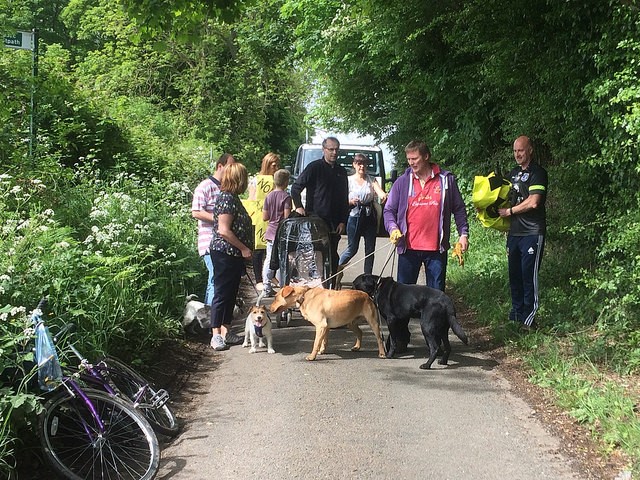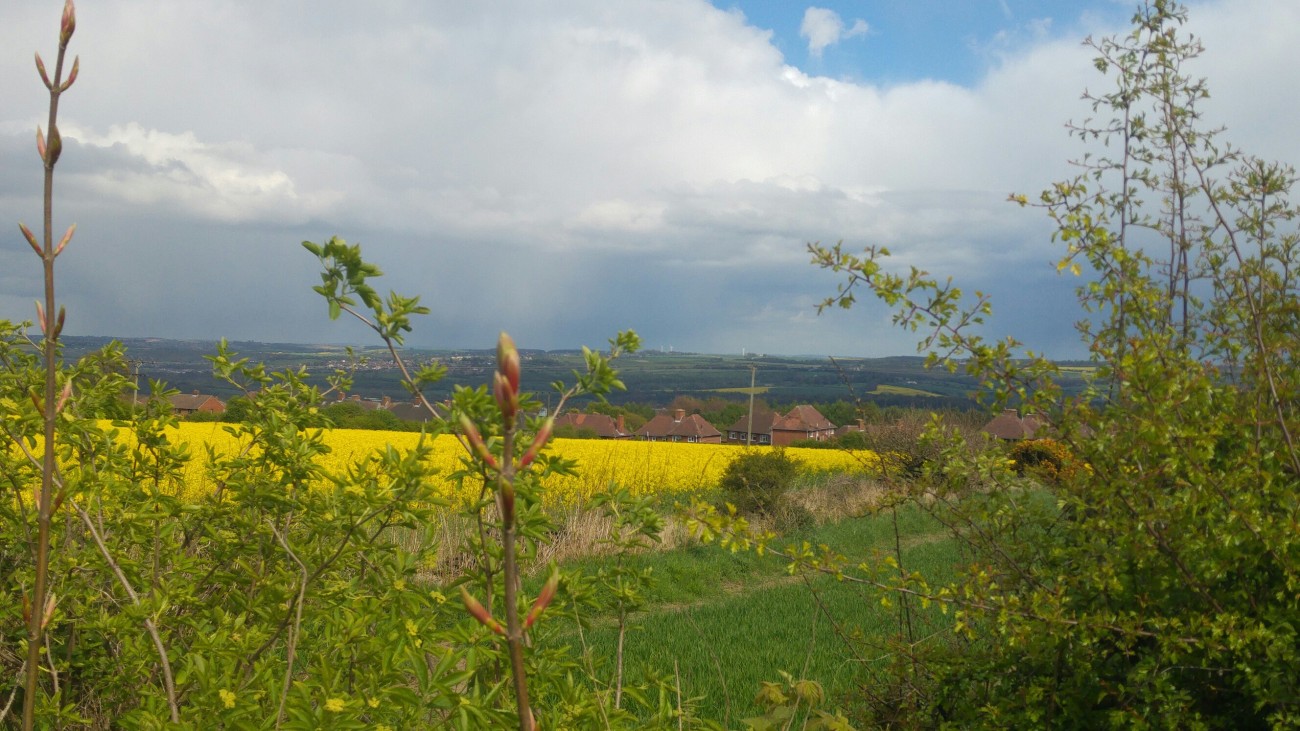
Common Road, Harthill, location of INEOS shale gas planning application. Photo: Harthill Against Fracking
The public consultation on plans by INEOS Shale to explore for gas in Rotherham borough ends this week.
The company is seeking permission for a vertical exploration well at Common Road, Harthill, in the greenbelt between Sheffield and Worksop.
The application website currently lists comments from nearly 200 people. The deadline is Friday 21 July 2017.
The closing date on INEOS’s other application, a similar scheme at Bramleymoor Lane, Marsh Lane, in Derbyshire, has been set for 10 August 2017.
Neither application includes hydraulic fracturing. But INEOS has said it may seek permission for fracking at either site in future and opponents say this should be taken into account.
Common Road, Harthill

Common Road, Harthill. Photo: Harthill Against Fracking
INEOS is seeking permission for five years to drill a 2,800m well at Harthill to take core samples and carry out a pressure test.
The site is within an area of high landscape value and a local wildlife site.
Opponents of the scheme have raised concerns about traffic volumes, unsuitable access roads, noise and vibration, light pollution, impacts on the landscape, the use of high quality agricultural land and threats to groundwater and wildlife.
Food and Water Watch Europe, a Brussels-based campaign group, has also argued that Rotherham Council must take into account fracking when it decides on the exploration well.
Rotherham Council said in a screening opinion published in May that the Harthill scheme would be “a discrete proposal” and should not be regarded as an integral part of a more substantial project”.
But Food and Water Europe’s fracking policy advisor, Andy Gheorghiu said:
“Hydraulic fracturing is a crucial part of the exploration phase contemplated here. Without the so-called `stimulation drilling` a company cannot ascertain if there are enough economically viable gas volumes in the underground. Once they make that positive determination, full scale fracking will inevitably ensue.”
He said if the results of drilling and tests at Harthill were promising the company would eventually apply to frack the well.
“We strongly disagree with the view that this exploratory vertical well development should not be regarded as an integral part of a more substantial project since it is most certainly not a discrete proposal that could proceed independently.”

Common Road, Harthill. Photo: Harthill Against Fracking
Mr Gheorghiu said the council must take account of impacts of the proposal on biodiversity, people, environment, heritage and landscape. Councillors should consider any secondary, cumulative, short-long term and permanent or temporary effects, he said.
The Harthill site is in Petroleum Exploration and Development Licence (PEDL) 304. This is on the northern edge of a group of licences operated by INEOS Shale, which stretch from the edge of Nottingham to Sheffield, taking in much of Sherwood Forest.
Mr Gheorghiu said permission for Harthill would “eventually lead, bit by bit, to the inevitable industrialisation of your region”.
“Any kind of permission given for the development of the site at Harthill will eventually have an effect on the development within this cluster of PEDLs itself and – as the process of shale development in the overall targeted area takes hold – would also have a negative and irreversible effect on the worldwide known, national treasure Sherwood Forest.
“The Rotherham Metropolitan Borough Council should not prioritize the single economic interest of a private company over the other existing, competing public interests in the targeted area.”
Food and Water Watch Europe’s partner organisation in the US has campaigned successfully for bans on fracking in New York State and Maryland.
- This afternoon, the Environment Agency granted a standard rules environmental permit to INEOS for the Harthill borehole. A spokesperson for the Environment Agency said:
“Our regulatory controls for onshore oil and gas are in place to protect people and the environment. Standard Rules permits are common across industry and maintain high levels of environmental protection. They do not allow companies to carry out fracking – this activity requires a bespoke permit application which would be subject to a site-specific environmental risk assessment and extensive public consultation.
“As with all decisions on whether to issue environmental permits, we will assess a company’s “proposals to ensure they meet strict requirements. If an activity poses an unacceptable risk to the environment, the activity will not be permitted.”
Links for Common Road, Harthill
Food and Water Watch Europe submission on Common Road, Harthill planning application
Frack Free South Yorkshire comment letter
DrillOrDrop details on the Common Road application
DrillOrDrop timeline for Common Road
Environment Agency permit and documents for Common Road, Harthill
Bramleymoor Lane, Marsh Lane

The village of Marsh Lane from Bramleymoor Lane. Photo: DrillOrDrop
The public consultation on the INEOS application for Bramleymoor Lane in north east Derbyshire has another three weeks to run, until 10 August 2017.
The company is seeking permission for five years for a 2,400m vertical coring well in the Green Belt, about 300m from the nearest homes in the village of Marsh Lane.
The campaign group, Transition Town Chesterfield, said today nearly 80,000 people had signed a petition to stop fracking in Derbyshire.
“The first step to stop fracking in Derbyshire is to object to this application [for Bramleymoor Lane] – so the time for action is now!
“A show of public support against fracking is very important.”
Transition Town Chesterfield said INEOS had failed to make the case for the need for the Bramleymoor Lane project and the application did not comply with key local planning policies or the UK’s targets to reach greenhouse gas emissions.
The group called on councillors to consider the wider potential cumulative impacts of fracking.
“Although this application is for an exploratory well only this is inextricably linked to future plans for hydraulic fracking of shale gas. This is clearly acknowledged by everyone involved. Therefore this application cannot be considered in isolation but as part of a staged process towards eventual fracking.
“To consider this development as a stand-alone development would be analogous to considering the development of an airport runway in isolation from the aviation traffic it was built to support, or considering the development of the foundations for a house separately from the house construction.”
Links for Bramleymoor Lane, Marsh Lane
Link to Bramleymoor Lane application website
Transition Town Chesterfield comment on Bramleymoor Lane application
DrillOrDrop details on the Bramleymoor Lane application
DrillOrDrop timeline for Bramleymoor Lane
Categories: Regulation

Well, South Yorks. police seem to be gearing up their helicopter forces ready to film a bit of earth moving! Seems the instructions were a little opaque.
I wonder if the gnomic Mr Gheorghiu has been to the area? South of the ex colliery villages of Dinnington and Kiveton Park, and a bit further, the late lamented Maltby Colliery, a stones throw from the M1, and as good as in the Rother Valley as one can get ( well industrialised in the past ). The area is de industrialised, but not de populated, and some are not so happy many jobs went abroad.
I do not think, that by any stretch of the imagination, fracking would result in the re industrialisation of the wider area, to the level it was during the middle of the industrial revolution.
Dear Council, What will be gained by the people you represent, who live in this area? Jobs..no. Jobs in this industry go to outside, brought in, experienced professionals. ‘But they are only doing a little test well’, you may argue. Don’t be naive. They are a fracking company, out for profit. They don’t waste money on doing just ‘a little test well’. ‘But they will clean up after themselves’. That comment is CULPABLE IGNORANCE. The evidence is out there. Research the aftermath of fracking in the USA and Australia, before you make your decision.
Maggie
You are right to point out that the jobs will come from outside the immediate area. Unless you have a number of competent people sat at home waiting for the call, skilled workers will come from outside the area.
The good news is that local haulage contractors and civils contractors can be immediately involved in the groundworks. Local drilling companies such as Marriotts of Chesterfield may benefit, as they have from the activities in Lancashire.
Local hotels, pubs and B&B will benefit.
If the industry develops, them more immediate local labour would be involved, as well as well paid expertise moving to the area, to the benefit of house prices and the local community maybe.
The final point on this is, …. how local is local?
The case of Shirebrook and Sports Direct has been well aired, and their need to import workers from other parts of the EU, as indeed have Pears at Marnham, for their new biomass power station.
I can think of no recently established industry in the U.K. which has managed to exist on local labour alone, and certainly not from a radius of a few miles.
Regarding profit, I agree. Like Farmers, Butterfly farms, hairdressers, delivery companies, non charity shops and Cafes, engineering companies, fuel retailers, dentists, opticians, steel companies, etc etc, they are out to make a profit. I know of no drilling charity.
The Well is a test well, but you are correct in assuming that, if economiclly viable amounts of gas are discovered, then INEOS may wish to drill further wells and frack them. However, as I understand the council has to consider the issue in front of them, which is a exploratory well. If Ok and more development is required, it goes to the planners again, with a new plan. Others may correct me, but they cannot consider the impacts of multiple fracked wells when the application is for an exploratory well.
The clean up is a similar case. The clean up from a single well is not a big issue. To see how old oilfields look in the UK, you have to look no further than the Eakring Oilfield, or the Egmanton oil field ( a mile or so from where I live), which few people know was or is there. The cleanup of the Egmanton oilfield is ongoing.
Closer to home, there are 2 abandoned wells to the West of Todwick which may be worth checking out to get a sense of how single well abandonment is managed locally.
I think the culpable ignorance assertion is not relevant for this single well, given the existing U.K. Track record.
Should the industry develop, and applications for multiple fracked wells, pipelines, compressor stations etc etc, turn up, then that would be something else to be considered.
Maggie-I think you need to do a little more research about Ineos! You might just find they employ a very large number of people in the UK, and around the world. There was an advert. recently detailed on DOD for operatives to work on the required seismic surveys. I suspect for other work there may be a number of experienced operatives out of work from the north sea sector that would welcome such employment. (A large solar farm a couple of miles from myself was built by a gang of workers brought in from overseas, who departed as soon as it was completed-so alternatives are a potential problem as well.)
Yes, Ineos are very profitable but they have recently invested a huge amount of that profit into the UK economy and are looking to add at least £500m to develop fracking in UK, and maybe, a new car factory.
Either you have them confused with another company or you have not researched them very well.